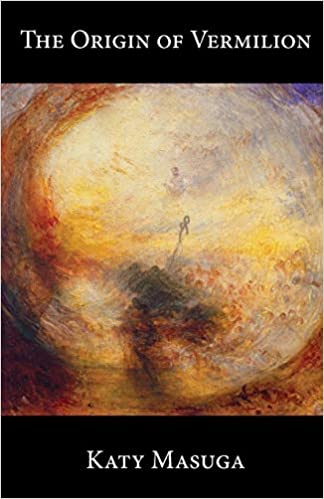The mining of cinnabar, the mineral form of vermilion, was a life-shortening enterprise before synthetic vermilion was developed. Cinnabar is highly toxic material, laced throughout with deadly mercury, and miners pulled its scarlet brilliance from the earth at their own peril. In The Origin of Vermilion, Katy Masuga mines the toxic veins of human desire, abandonment, yearning and loss found in histories that span the globe, all of which connect at their deepest points. Her work gives the reader new eyes for viewing histories as stories, told by storytellers that influence the beauty, the pain and the revelations within with each turn of time and phrase. A careful and complex study of language, light, maps and mirrors makes up her documented dreamscapes.
The reader is greeted by a breathless child’s tale of her gramps who lives in the chicken coop. The child’s name is Shirt, and Shirt’s life provides the structure for the novel and influences how the rest of the stories are told. Her spirited strings of essential details flow evenly, circling back to the chicken coop for safety:
I didn’t want to go to no school away from gramps, and I thought it was just fine living evenings by the candlelight and listening to him tell stories each night and carrying on just like we did, and we weren’t bothering no one even if Eva still didn’t get herself enough culture, but I don’t know what I might have had to do with it anyway. I didn’t much mind going to school just where I was, though I didn’t much like it either. But I would do it if it meant I could keep coming hear gramps tell his stories. (3)
Shirt’s story makes up five anchor points in the novel, moving from standard narrative fiction into stream of consciousness. One of the most compelling sections is made up entirely of copied birth, death and marriage certificates. By the time the reader encounters the certificates, Masuga has made adept investigators of historical documents out of her audience. With Scheherazade’s grace, Masuga introduces stories within stories, following dreams, notes in the margins of used books and museum exhibits that serve only to display that something is lost, leaving her readers with a delicious ache for the promised moment that these distant things will collide into meaning. What appear to be loosely woven pieces of philosophy and bits of untold historical drama have a way of revealing something elemental about human perception and the art of storytelling itself. As Masuga follows a train of thought that leads her to reflect on the assassination of Archduke Franz Ferdinand and his wife, she writes:
It seems there is a time and place for accuracy, or what we call accuracy is malleable, depending on the circumstances of the story or, as they say, who that storyteller may be. That the Archduke spoke the words he did of his love for his wife and family and of his honor and his overcoming of the pain in his final breath, that his wife died immediately and did not suffer, that she died upon him in a gesture directly motivated by her care for him…these items alert the reader not to inaccuracies necessarily but supremely to the arbitrarity not of writing history but of remembering it. (26-27)
The first-person narrator slips through time and perceptions, but primarily reads as Masuga herself. However, the storytelling can without warning sound like the man with the watch from another time who haunts Masuga and who himself is haunted by dreams of love and the completeness of family. Her story is told from Paris, remembering treks across Mongolian plains and runs through London’s streets with the red dust of Mongolia still in her shoes. Sometimes, she remembers Paris as well. The trip to Mongolia is reinforced with photographs, supporting the truth of it happening, and yet there are other trips that fall into fiction and fantasy, connecting back to the non-fiction elements as metaphor. This melding of the real and the fantastic is no accident as she analyses Goethe’s Faust:
Through the haunting tales of Goethe we arrive at a picture even more confounding where relying on the imaginary to enhance the real is disrupted not only by an actual infiltration of the real by the imaginary, thus eliminating the boundary between the two, but by the painful consequences of the imaginary on the real that are often met with an apathy from us that serves to highlight, on a universal level, how paradoxically insignificant and precious the individual experience may very well be. (47)
Masuga’s disruptions of the “I,” and thus the eye of the story, compels the reader to ask at any given moment in the narrative, “Who is I?” The longing to correct the phrase plunges the perspective into the readers themselves with, “Who am I?” Ultimately, this is the dangerous question that is asked throughout the novel, both by Masuga and, subsequently, her readers. Her journey into herself becomes something that demands resolution, and the reader believes in the dream and the reality simultaneously. She writes, “I daydream a labyrinth that I navigate to the end, discovering finally the purpose of the dreams of my mother and of the man with the watch” (71).
Masuga’s yearnings are made apparent by what she notices. In Mongolia she takes note of a family riding the same bus: “They shared a bright blue sugary drink, and one by one, during the remaining one and a half hour journey into the heart of Tarej, the baby fell asleep on the lap of the mother, the mother fell asleep on the shoulder of the father, the father fell asleep on the mother, his crown touching hers” (74). The moment mirrors the last moments of Archduke Ferdinand and his wife, in postures of care and love. Masuga’s view of history is seen through the lens of a tragic and hopeless desire for a mother’s love. While writing of Bohme and his influence on the German Romantics, she turns once again to her dreams:
Schelling elevates the beauty of Sehnsucht, the longing, that permeates darkness and allows it to be penetrated by light. Such a Sehnsucht is not simply an escape out of darkness into light but an actualization of the one with the other… I wonder about my mother and this Sehnsucht that I might feel towards what is missing but can never be recaptured. I want this darkness to enter light, but it can only be a forward motion now and nothing to return to. (153)
Masuga renders memory on the page much like it is experienced in real life. A memory can play out like a movie projected onto the present, melding images of what was with what is. While she is in London, with Mongolian dust in her running shoes, the reader experiences two scenes overlapping in a beautiful and reckless image of the stately National Gallery as a backdrop for memories of “bands of horses running across the plains” (184). While “looking with real, living eyes for the first time at Cezanne’s Bathers and the Caspar David Friedrichs,” the horses, yaks and cattle from her memories fuse with some of the finest paintings of Western culture (184). She notices the smells and the sunlight and the salt from her sweat “covering her face and neck”(184). In the gallery, she catches her reflection, and the reader slips into a mirrored moment with the author. Masuga includes the reader by looking only at universal aspects of being instead of physical particulars. She writes:
Sometimes when I look at myself that way at home, dead, still vacant in front of a mirror, I think it is always a bad idea. It is as though I am melting, sliding off the frame, the bones of my body. My features getting old and worn before my eyes. There in the gallery it was something different though. I was alive, and full. I was reflected as I was meant to be—dirty, sweaty, exhausted, vigorous, alone, with the whole world around me with some perceptible change since returning from Mongolia, since the dreams began (186)
Masuga merges deceptively disparate facts into a new perspective that supports the narrative’s goals by echoing back to Shirt’s story. Each section that fills the void between Shirt’s stories is built upon a constant string of connections between, for instance, Black Elk, Calamity Jane, Steven Jay Gould, Phillip III, and a battalion of names that one is all the better for now knowing thanks to Masuga. This continuous march of stories is comprised of a lot of souls to mentally feed and care for on this journey, all bearing their own heavy loads of facts that need cataloguing. It is a lot for the reader to carry, especially considering that when the underlying narrative finally surfaces in the most resonant passages of the novel, a return to the cataloguing and fact-following saps the energy of the moment. The histories become distractions rather than cherished clues. However, Masuga seems aware of her demands, shaping the narrative in such a way to strengthen her point:
When we learn stories, and when we learn history, we try to make sense of the information we’re given by piecing it together to form a whole. Sometimes the process is so fine-tuned that it goes unnoticed. The information comes from disparate sources; it develops over time; we learn part here and there, and we construct and make sense of the collective story using the model of what we thought was the truth as given to us (250).
Ultimately, Masuga’s narrative must merge with Shirt’s story, and her brilliant eye for connections must be turned inward. This is handled in a way that is satisfying for readers who enjoy the off-world, extra-dimensional story telling of authors like Italo Calvino or Haruki Murakami without alienating committed readers who muscled through Schopenhauer and Foucault to get to a resolution that is grounded and relatable. Her novel risks accessibility by leaning heavily on an eclectic mix of names to support her points, but for the persistent, and perhaps stubborn reader, Masuga offers metaphors that can be held firmly in hand and used when needed because they were forged from the depth and pain of her story.
In closing, the unveiling of each new association, connection and truth is so rewarding to discover that it would be criminal to reveal much more about The Origin of Vermilion, but consider how well Masuga appreciates how this reviewer’s response is one of many possibilities, because “aggregating ideas is the collective experience that defines us, constitutes us before we are born, before we knew into what we were being born and what would grow in us as we grew into the skin holding our insides in place. We are also broken apart as a unity through the individual experiences that we undertake, whether that is in action, in voice, in all of our senses” (254).





